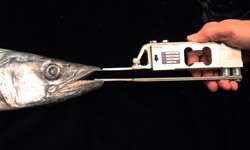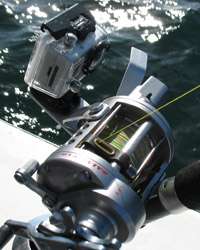Studying the Noble King Mackerel

They are sometimes called "smokers," due to the speed at which a fishing line zips out the reel and "smokes" after they hit on the bait.
The king mackerel, one of the most popular recreational fish in the Gulf of Mexico, strikes hard and makes long runs, providing anglers with a challenging fight to land the fish, which commonly ranges from 20 to 30 pounds.
And, while the "bite force," or strength in the jaw muscles, of other fishes have been measured, there is little known about the bite force or speed of a bait strike by a king mackerel, or how quickly the fish can accelerate. Until now.
Amber Ferguson, a graduate student working with University of South Florida Biology Professor Philip J. Motta, has combined her biology and math skills with some unique technology advancements to take a closer look at how the king mackerel operates in its predator mode.
"She is starting to get some extraordinarily good data," said Motta, who is renowned for his work in studying sharks. "No one has measured strike force of fish in a natural environment."
Twice, so far, Ferguson and Motta have ventured out into the Gulf of Mexico to hunt the king mackerel, which are common in the area in the fall and spring. They caught one fish in November, but had tremendous results in April, about 20 miles off Madeira Beach, when they landed six king mackerel.

They used a specially-adapted fishing reel that featured a line counter and a mounted GoPro camera to record the line counting on video, providing time and length of line pulled out during a violent strike. Ferguson is using the data to calculate the speed of the strike, and from that how the king mackerel accelerates through an attack and how "strike force" impacts the "bite force" of the fish.
"There is a lot of force being generated by how fast they swim," Ferguson said. "A lot of time we just look at bite force. Now we are looking at strike force, too. We want to get the whole story on how the fish are feeding."
The measurements taken so far, Ferguson said, revealed one king mackerel was traveling at six to seven body lengths per second during a strike – about 15 miles per hour.
"That's pretty quick for a fish," said Ferguson, who is studying for a master's in biology and intends to pursue a doctorate in the same field.
In fact, Ferguson was just notified this month that she is a recipient of a $5,000 Guy Harvey Ocean Foundation Student Scholarship Award, named after the popular artist of marine life scenes.

Ferguson hopes to fine-tune the results of her research during the Fall semester, and then work on publishing a paper. The king mackerel is an important commercial and recreational fish in Florida. Recreational fishing in the state pumps millions of dollars into the economy annually.
Ferguson and Motta said the research results could provide valuable information to companies that make fishing equipment and especially lures used to attract king mackerel. The industry would welcome more information on how the fish strike and attack prey.
The Gulf of Mexico king mackerel migrate between the Texas and Florida coasts. The Atlantic king mackerel migrates between North Carolina and Florida's east coast.
"This research is unique, informative and of high interest in the Gulf of Mexico and South Florida areas," said Motta, who is with USF's Department of Integrative Biology.
Provided by University of South Florida














